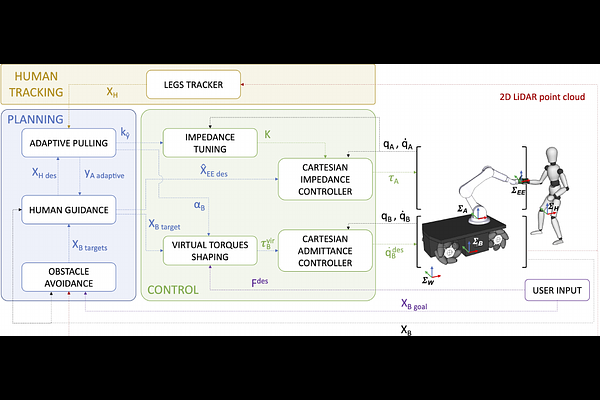Robot-Assisted Navigation for Visually Impaired through Adaptive Impedance and Path Planning

Robot-Assisted Navigation for Visually Impaired through Adaptive Impedance and Path Planning
Pietro Balatti HRI2 Lab, Istituto Italiano di Tecnologia, Genoa, Italy, Idil Ozdamar HRI2 Lab, Istituto Italiano di Tecnologia, Genoa, Italy Dept. of Informatics, Bioengineering, Robotics, and System Engineering. University of Genoa, Genoa, Italy, Doganay Sirintuna HRI2 Lab, Istituto Italiano di Tecnologia, Genoa, Italy Dept. of Informatics, Bioengineering, Robotics, and System Engineering. University of Genoa, Genoa, Italy, Luca Fortini HRI2 Lab, Istituto Italiano di Tecnologia, Genoa, Italy, Mattia Leonori HRI2 Lab, Istituto Italiano di Tecnologia, Genoa, Italy, Juan M. Gandarias Robotics and Mechatronics lab, Systems Engineering and Automation Department, University of Malaga, Malaga, Spain, Arash Ajoudani HRI2 Lab, Istituto Italiano di Tecnologia, Genoa, Italy
AbstractThis paper presents a framework to navigate visually impaired people through unfamiliar environments by means of a mobile manipulator. The Human-Robot system consists of three key components: a mobile base, a robotic arm, and the human subject who gets guided by the robotic arm via physically coupling their hand with the cobot's end-effector. These components, receiving a goal from the user, traverse a collision-free set of waypoints in a coordinated manner, while avoiding static and dynamic obstacles through an obstacle avoidance unit and a novel human guidance planner. With this aim, we also present a legs tracking algorithm that utilizes 2D LiDAR sensors integrated into the mobile base to monitor the human pose. Additionally, we introduce an adaptive pulling planner responsible for guiding the individual back to the intended path if they veer off course. This is achieved by establishing a target arm end-effector position and dynamically adjusting the impedance parameters in real-time through a impedance tuning unit. To validate the framework we present a set of experiments both in laboratory settings with 12 healthy blindfolded subjects and a proof-of-concept demonstration in a real-world scenario.